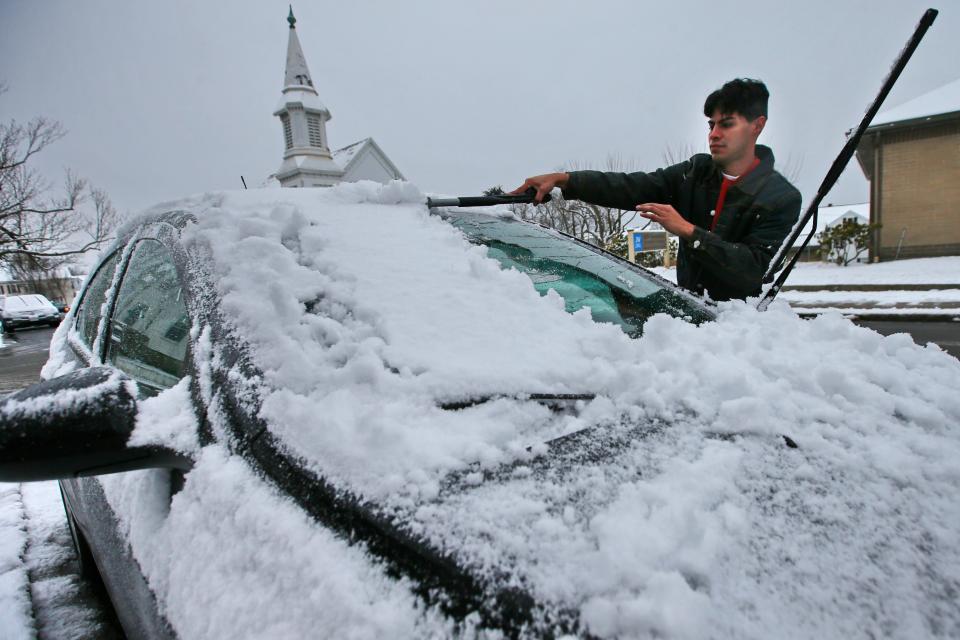Turn up the heat, it’s going to be frigid this weekend. Snow is on the agenda once again, with an expected 1 to 3 inches to hit the SouthCoast on Friday. Arctic air is set to make Saturday and Sunday the coldest days of the season so far, with high temps in the 20s.
As we head into the frosty days ahead it’s crucial that we prepare for the wintery weather conditions, especially as we head out on the road. More than 150,000 auto crashes occur annually due to icy roads, Federal Highway Administration data shows.
This weekend: Bundle up, SouthCoast: Snow and single-digit temps on the way
It’s important to be prepared to drive in these hazardous conditions, we talked to AAA Northeastern to get some tips to help you have a safe journey during the upcoming snow days.
“For those who can, staying safe at home is always the best option,” said Mary Maguire, Vice President of Public/Government Affairs at AAA Northeast. “But for those of us who are compelled to drive in wintry conditions, the best course of action is to allow more time, slow down, and increase your stopping distance.”
Give yourself time in the morning
Nothing is worse than when you wake up to your car covered in snow and ice, it can throw your whole morning off leaving you will little time to properly clear it off.
Frozen doors, dead batteries, flat tires How to prevent these winter woes
“The worst mistake people make with their cars in this type of weather is not giving themselves enough time to clear snow and ice from their cars before driving off,” said Mark Schieldrop, Senior Spokesperson/Public Affairs at AAA Northeast.
He recommends getting a head start on clearing ice and snow before the storm ends, leaving you with less work in the morning.
Steps from Schieldrop for clearing off your car properly:
Make sure wipers are off to prevent damaging them.
Check your tailpipe for obstruction and then start the car with the defrosters on.
Remove the snow from top to bottom, making sure to use a long snow broom to clear the roof.
Make sure you are pulling snow toward you; it requires less effort.
A good ice scraper is essential to finish the job, pull your wiper blades up before gently removing the ice from the windows.

“Driving with snow cascading from your car’s roof can limit visibility for others on the road, putting them in danger. It is also against the law in Massachusetts,” said Schieldrop. “Don’t be that person who sends dangerous chunks of ice into other drivers’ faces.”
Driving in winter conditions
The upcoming snow followed by the freezing temperatures is sure to create hazardous driving conditions.
AAA offers the following tips while driving in snowy and icy conditions:
-
Beware of black ice: Black ice is often difficult to see, and bridges and overpasses are especially prone to black ice formation. To be as safe as possible, make sure your windshield is fully defrosted before you head out to have maximum visibility.
-
Drive slowly. Always adjust your speed down to account for lower traction when driving on snow or ice.
-
Accelerate and decelerate slowly. Apply the gas slowly to regain traction and avoid skids. Don’t try to get moving in a hurry and take time to slow down for a stoplight. Remember: it takes longer to slow down on icy roads.
-
Increase your following distance. Allow five to six seconds of following distance between your vehicle and any vehicle in front of you. This space allows you time to stop safely if the other driver brakes suddenly.
-
Know your brakes. Whether you have antilock brakes or not, keep the heel of your foot on the floor and use the ball of your foot to apply firm, steady pressure on the brake pedal. Don’t pump the brakes.
-
Don’t stop if you can avoid it. There’s a big difference in the amount of inertia it takes to start moving from a full stop versus how much it takes to get moving while still rolling. If you can slow down enough to keep rolling until a traffic light changes, do it.
-
Don’t power up hills. Applying extra gas on snow-covered roads just starts your wheels spinning. Try to get a little inertia going before you reach the hill and let that inertia carry you to the top. As you reach the crest of the hill, reduce your speed and proceed downhill slowly.
-
Don’t stop while going up a hill. There’s nothing worse than trying to get moving up a hill on an icy road. Get some inertia going on a flat roadway before you take on the hill.
Maguire points out how important it is to have an emergency kit in your car. “Travel with a winter emergency kit containing everything from blankets, battery-powered chargers, water, snacks, de-icer, scraper, snow brush, and extra windshield wiper fluid,” she said. “This is especially important when you’re traveling with children.”
This article originally appeared on Standard-Times: Tips for driving in winter conditions on the SouthCoast
Signup bonus from




